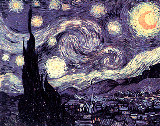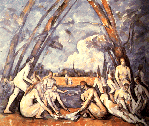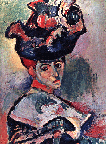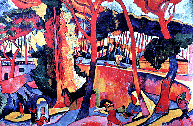

The next step in the process of changing form was to eliminate recognizable subject matter altogether. Art which concerns itself primarily with the formal elements and has no evident subject matter apart from these elements can be referred to as non-objective art. Some of the non-objective artists whose work might be shown in class are Mondrian, Kandinsky, Pollock, and Vasarely.
While in a sense painting has always been "abstract" in the sense that it attempts to depict the three dimensional world on a two dimensional surface, many modern artists have more dramatically and intentionally simplified, modified, and selected from nature. Among the important movements in art which exemplify these changes in form are the following:
 Beginning
in the 1870's, this movement introduced a new, bolder, and more tactile way of
painting which suited their content interests. The subject matter of the Impressionist
was, above all, light. Impressionist painters virtually always worked directly
from nature, not in the studio, which was the traditional method. Whether depicting
a human figure, a still life, or a landscape, the concern was not so much with
subject per se but with the transient qualities of light which revealed
or obscured forms. This transient quality resulted in techniques of painting which
were described by a critic as "Impressions" - a term intended to be derogative.
Monet was the most well
known of the impressionists.
Seurat
was the founder of a related style, known as pointillism. The Post Impressionists,
who shared some qualities with this movement, included
Beginning
in the 1870's, this movement introduced a new, bolder, and more tactile way of
painting which suited their content interests. The subject matter of the Impressionist
was, above all, light. Impressionist painters virtually always worked directly
from nature, not in the studio, which was the traditional method. Whether depicting
a human figure, a still life, or a landscape, the concern was not so much with
subject per se but with the transient qualities of light which revealed
or obscured forms. This transient quality resulted in techniques of painting which
were described by a critic as "Impressions" - a term intended to be derogative.
Monet was the most well
known of the impressionists.
Seurat
was the founder of a related style, known as pointillism. The Post Impressionists,
who shared some qualities with this movement, included
| Van Gogh, | 
|
Gauguin, Cezanne, | 
|
and others. |

 The short-lived movement known as Fauvism appeared just after the turn of
the century, and has been described as the first truly abstract style in that
their preoccupation with color and form caused them to depart from the reality
of what they actually saw. These artists were influenced by aspects of the work
of Cezanne ,
Van Gogh, and Gauguin.
For the Fauve painters, color was the primary subject matter, and the forms of
landscape, figure, or portrait were merely a vehicle for their experimentation
with vivid color relationships. "Fauve" is French for "Wild Beast," and was a
term used by a critic to describe a group of paintings displayed at a Paris exhibiton
in 1905. Color was applied to the canvas in ways that had little or no relation
to the actual color of the objects as seen, the purpose being to experiment with
color behavior. Among the artists who participated in this style were
Matisse,
Vlaminck, and
Derain.
The short-lived movement known as Fauvism appeared just after the turn of
the century, and has been described as the first truly abstract style in that
their preoccupation with color and form caused them to depart from the reality
of what they actually saw. These artists were influenced by aspects of the work
of Cezanne ,
Van Gogh, and Gauguin.
For the Fauve painters, color was the primary subject matter, and the forms of
landscape, figure, or portrait were merely a vehicle for their experimentation
with vivid color relationships. "Fauve" is French for "Wild Beast," and was a
term used by a critic to describe a group of paintings displayed at a Paris exhibiton
in 1905. Color was applied to the canvas in ways that had little or no relation
to the actual color of the objects as seen, the purpose being to experiment with
color behavior. Among the artists who participated in this style were
Matisse,
Vlaminck, and
Derain.
Here is a link to additional Fauve images.
| |
 |